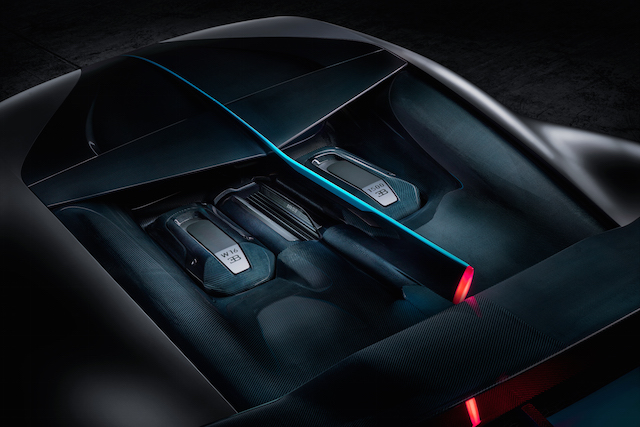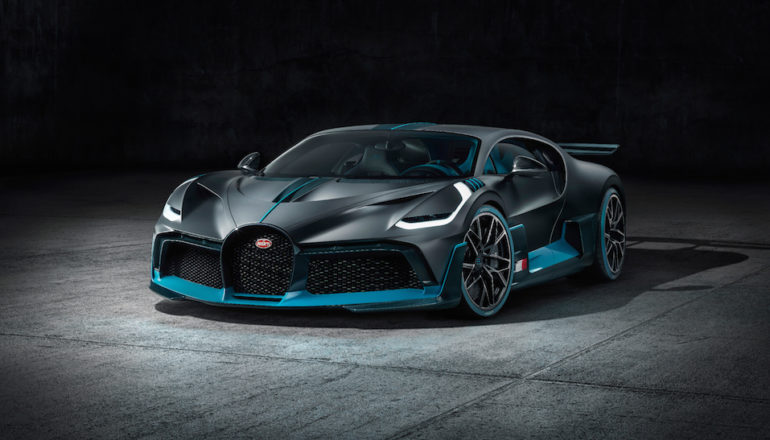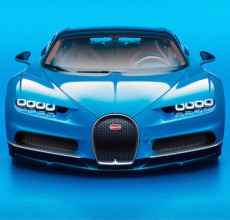Bugatti has introduced a car that is not only about being lighting quick, but about being lightning quick in corners and bends. The Divo was unveiled in California at the exclusive event “The Quail – A Motorsports Gathering” on Friday, the 24th.

How quick is it – quick facts
The French luxury brand has developed a super sports car tuned for agility, nimbleness and optimum handling performance on winding roads. The new Divo, as it is named, is powered by Bugatti’s iconic eight-litre W16 engine with a power output of 1,500 PS or 1480 hp. The aerodynamics of the model have been intensively fine-tuned; the suspension and chassis settings have been modified; and the weight has been reduced by 35 kilograms compared with the original Chiron. As a result, the Divo generates 90 kg more downforce than the standard Chiron and the lateral acceleration has been boosted to 1.6 g. Its maximum speed is limited to 380 km/h (236 mph) but the Divo can lap the Nardò handling circuit in southern Italy eight seconds faster than the Chiron.
According to Bugatti President Stephan Winkelmann: “The Divo has significantly higher performance in terms of lateral acceleration, agility and cornering. The Divo is made for corners.” It is planned as a road vehicle with a net price of 5 million Euros. The limited initial series of 40 Divos have already found their owners.

Chiron in comparison
Bugatti’s patented 8.0L W16 powerhouse has retained its peak power output for the Divo at 1500 PS. The Chiron has a lateral acceleration of 1.5g. The Chiron has set a world record for highest speed at 400 kmph and its top speed is set to a maximum of 420 kmph. The Chiron Sport is 18 kg lighter than its original but the Divo is 35 kg lighter.

The car called Divo
The name Divo isn’t just a male version of “diva” as one might hastily conclude. Just as Chiron was derived from Louis Chiron and Veyron from Pierre Veyron, this too comes from the name of Albert Divo who was a two-time winner of the famous Targa Florio race on the mountainous roads of Sicily with Bugatti in the late 1920s.
“The step that we have taken with the Divo in terms of agility and high-performance cornering dynamics can be compared with the overall development from the Veyron to the Chiron.“ – Stefan Ellrott, Head of Technical Development

More sophisticated aerodynamics for cooling and downforce
The details of aerodynamic improvement is spread all over the redesigned body of the Divo. The air intakes on the front cover reduce the effective cross-sectional area of the vehicle and at the same time ensures improved air flow at the front and increasing aerodynamic efficiency. An optimized “air curtain” makes for better airflow over the sides. A wider front spoiler provides higher downforce and guides more air to the front air inlets. This way, the cooling system receives a higher mass flow improving overall cooling performance.

Cooling the brakes: The brakes are cooled by four independent air sources on each side of the vehicle: air flows in from the high-pressure area above the front bumper, the inlets on the front wings, one inlet on the front radiator and the diffusers ahead of the tyres. Vanes direct the cold air from these areas onto the brake discs. A heat shield carries the hot air out through the wheels, preventing the brakes and tyres from overheating. This is an improvement on the system on the Chiron, with additional support from the vacuum generated by the air curtain on the tyres and ventilation for the wheel arches via slats on the wings.
The roof of the Divo has been designed to form a NACA air duct, a flow-optimized air inlet and along with the specially designed engine compartment cover, this ensures a very high air mass flow to the engine compartment, helping to keep the temperature at optimum levels.
The rear end of the Divo features a new, height-adjustable rear spoiler which functions as an air brake when turned forwards and is set to different angles for the individual driving modes. At 1.83 metres (72”) wide, the rear spoiler is 23 percent wider than on the Chiron. The downforce is also boosted by the redesigned rear diffuser that accommodates four tailpipes.
The total downforce generated is 456 kilograms, 90 kg more than on the Chiron.

New chassis and suspension settings as well as weight reduction for better cornering
When it comes to driving dynamics, the Divo is designed to be different by being sharper, more agile and more nimble. For this, the camber was increased. (Camber is the slight sideways tilt of wheels to make the car wider in effect and to aid turns) Along with the increased down force, this increases stability but restricts the top speed of the Divo to 380 km/h. The Divo experiences a lateral acceleration of 1.6 g.
Complementing these changes are the steering and suspension settings that ensure a more direct response and significantly sportier driving behaviour in all modes (EB, Autobahn and Handling). Obviously, there is no top speed mode as in the Chiron.
The Divo is 35 kilograms lighter than the Chiron. Lightweight design modifications include new lightweight wheels and a carbon fibre intercooler cover, fixing of the front diffuser flaps, a smaller amount of insulation material and the installation of a lighter sound system. For lightness sake, the stowage compartments on the central console and in the door trims have been omitted.
While the top speed is restricted, these agile handling and quick acceleration qualities allow the Divo to feel faster and also finish a lap at the Nardò handling circuit, eight seconds faster than the Chiron.













